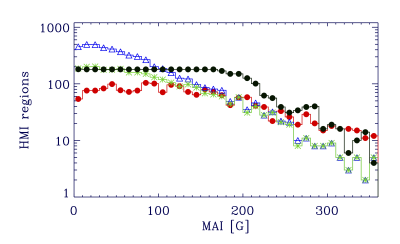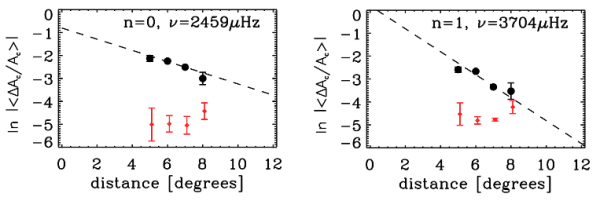Effects of Flares on Solar p-modes
| Nugget | |
|---|---|
| Number: | 408 |
| 1st Author: | Maria-Cristina RABELLO SOARES |
| 2nd Author: | Frederic BAUDIN |
| Published: | 26 April 2021 |
| Next Nugget: | Non-equilibrium ionization |
| Previous Nugget: | Subsecond Spikes in Solar Flare X-ray Flux as Seen by Fermi GBM |
Introduction
The interior of the Sun supports a huge array of standing waves, the celebrated p-modes of helioseismology. These oscillations contain energy, in varying amounts, and several attempts have been made to observe whether solar flares modes can contribute to their excitation. This was indeed proposed in 1972 by C. Wolff (Ref. [1]) We have now applied the modern technique of ring-diagram analyis to look for the impact of flares on the mode amplitudes (Ref. [2]).
Pitfalls: Firstly, we analysed several factors that affect the observed amplitudes of high-degree solar p-modes, namely line-of-sight limitations, strong magnetic fields and gaps in the observations. If not taken into account, the apparent changes in the observed mode amplitude could be misinterpreted as an effect of a flare. Care is required not only in analysing the flaring region but also in the comparison one that is used as the quiescent state to infer the change in the mode amplitude due to the flare in an ever-changing Sun.
The Halloween flare: Then, we investigate a single event, the largest flare in the space age (the "Halloween Flare" SOL2003-10-28T11:00), using solar magnetic-field data from MDI instrument. Contrary to earlier results (Ref. [3]), we did not find any amplification (larger than ≈5%) in the inferred mode amplitude during the flare, as opposed to the reported increase of more than 100%. This difference could be in part result from the lack of a correction for the line-of-sight effect as the observed region rotates in relation to the observer in the earlier work;. we found an increase of as much as 60% in the mode amplitude during the flare, when not taking this into account. On the other hand, we found that the scatter in the fitted mode amplitudes increases as the duty cycle decreases, especially when it is lower than 80%.
A statistical approach
Using HMI data, the analysis was applied to the regions corresponding to the flares observed during the high activity phase of Cycle 24 based on the Heliophysics Event Knowledgebase (HEK). The HMI data cubes were divided into three sets:
- "Strong Flares": those with peak flux larger than 1200 erg/cm2/s and/or GOES class M or X,
- "Weak Flares": with peak flux between 10 and 60 erg/cm2/s, and
- "Without Flares": where no flare was detected.
The first set is used as a comparison to the results of the strong flares in the second set. Figure 1 shows the distribution of the mean magnetic field of each tracked region (MAI) for each data set at 10 G intervals. Most of the Strong Flares regions (75%) have an MAI smaller than 200 G and only 10% larger than 290 G.
- However, for MAI > 240 G, there are more regions with Strong Flares (red) than regions with Weak Flares (blue), and for MAI > 300 G their number is similar to that of regions Without Flares (black).
- Although there are fewer regions of Strong Flares than Weak Flares for MAI < 180 G, there are still a large number with Strong Flares with MAI as small as 1 G.
The fact that flares occur in low MAI regions could be surprising. We can however speculate that the complex geometry (e.g., inclination, distant loop footpoints etc) of magnetic structures at the origin of the flares can explain the low value of the MAI.

Amplitude difference between regions with and without flares
We used an average of 20 quiet regions (with MAI < 1 G) at each disc position as a reference, AQ, to take into account of the line-of-sight effect.
In Figure 2 we compare the relative mode amplitude obtained in the Strong (SF) and Weak Flares (WF) set with those in the Without Flare set (WO) to look for an effect of a flare on the mode amplitude. However, to take into account the effect of strong magnetic fields on the mode amplitude, we also need to compare regions with similar MAI.

The differences of relative amplitude (Figure 2 left and centre panels) should be small since these amplitudes are observed in regions with similar MAI. However this is not the case, especially for regions with low MAI (as in Figure 2). In regions with Strong Flares (centre column), the mode absorption is even larger than for Weak Flares (left column).
A possible explanation for the mode-amplitude decrease observed in these flaring regions could be due to the strong magnetic fields usually present in and around a flare, more so for the Strong Flares.
Looking for a similar effect in our data, we show the median MAI in the neighbourhood (within 14°) of the regions analysed as a function of distance to its centre (rightmost column in Figure 2). It is larger for the Strong Flare set (red) than the Weak Flare set (blue) and both are much larger than the Without Flare set (black).
The effect of an active region on a nearby quiet region
The mode amplitude in a magnetically quiet tile is affected by a nearby active region by as much as 20% in its observed amplitude, as shown in Ref. [4]. The mode amplitude variation for 5° regions was calculated when there was an active region (with MAI > 100 G) in their vicinity, at 8° or less centre-to-centre, in comparison with quiet regions at the same solar disc location for which there were no neighbouring active regions (i.e., no region with MAI larger than 5 G) – Figure 3.
Conclusion
After taking into account the nearby active regions, we did not find any amplification in the inferred mode amplitude due to flaring activity larger than a 10% uncertainty (Figure 4).

Thus, we conclude that if there were a change in the solar acoustic
mode amplitudes due to the large energy released during a flare,
the change must be small. We did not find any individual flaring
region that had an increase in its mode amplitude outside the
uncertainties in our analysis (i.e., 2.5 σ = 25% variation).
For details, see Ref. [2].
References
[1] [href="http://adsabs.harvard.edu/abs/1972ApJ...176..833W "Free Oscillations of the Sun and Their Possible Stimulation by Solar Flares"]
[2] [https://ui.adsabs.harvard.edu/abs/2021arXiv210213181R "Effects of flares on solar high-degree helioseismic acoustic mode amplitudes"]
[3] "Variations in p-Mode Parameters with Changing Onset Time of a Large Flare"
[4] "Statistical Analysis of Acoustic Wave Power and Flows around Solar Active Regions"
